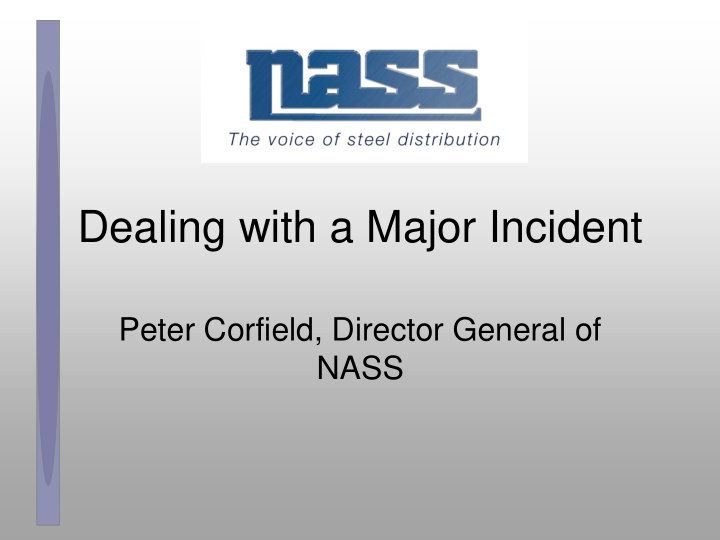



Dealing with a Major Incident Peter Corfield, Director General of NASS
Overview • Why bother to prepare? • Implications of an incident occurring • Practical Aspects – Legal Issues – Organisation – Investigation Process – Communication • Inquests/Civil/Criminal Proceedings
Implications of an incident occurring • Emergency services (Fire/Ambulance). • Legislation (Police/HSE/Local Authority) • Inquest/Court Proceedings Note: the death of an employee in the workplace is one of the most difficult issues you will ever have to deal with.
Practical Aspects – Legal Issues • Interests of company/employees/family of bereaved? • Understand external investigation process • Legal consideration of internal investigation • Communication/response team
Practical Aspects - Organisation Do people know how to react to a situation? • As Soon As Possible: – Inform key people (internal) – Ensure any persons attending the scene have “site briefing” and correct PPE – Who is going to oversee investigation? – Establish who will be involved in internal investigation – Understand role of witnesses/documents produced • What is the role of the Liaison Person?
Practical Aspects – Investigation Process (External) • Who will investigate and what powers do they have? – Police have a duty to investigate a potential crime – HSE/Local Authorities have a duty to investigate H&S incidents • Fatality – Agreed protocol between Police/HSE – Police take the lead (Primacy) – When police have conducted their enquiries they hand over primacy to HSE – HSE have powers to release area/process for normal duty
Practical Aspects – Investigation Process (External) • Interviews before commencement – confirmation of powers being used is crucial – Informal – Formal interview under S9 Criminal Justice Act (Voluntary) – S20 HSWA (Accompany person take notes) – PACE (Police and Criminal Evidence Act 1984) • Suspect? • Legal representation – Company representative • Under caution? • Right person? • Legal Advice (benefit or not)
Practical Aspects – Investigation Process (Internal) • Internal investigation required to comply with legal duty • Emphasis – helping “management of H&S” and discovering underlying causation • Review and revise working practices/risk assessments • Extract learning's from incident
Practical Aspects – Investigation Process (Internal) • Investigation group – Agree protocol regarding evidence required, interviewing people, viewing/taking of documents, taking/testing/analysing articles and substances – Agree protocol regarding effective means of identifying how and why accidents occurred and help prevent reoccurrences – Provide investigating officers with information about organisation, process flow of material, workings of relevant plant and equipment, details of who was at scene etc
Practical Aspects – Investigation Process (Internal) • Investigation report/findings: – Content – Interested parties • Insurance company • Litigation (personal injury/property etc.) • Enforcement The purpose of litigation and enforcement is to apportion blame!
Practical Aspects – Communication • Interested parties: – Senior people in your organisation – Family of the injured person – Employees – Trade union representatives – Shareholders – Legal/insurance advisors – Suppliers/customers – Media
Practical Aspects – Communication • Press Release – You cannot control the media but you can control media communication – Do not release details until next of kin informed • Police/public authority may do this – Content – brief and factual • On-going – put in place a process to deal with internal/external requests
Practical Aspects – Communication • What the media will want to know: – What happened? – Were there any deaths or injuries? – What is the extent of the damage? – Is there any danger or future injuries/damage? – Why did it happen? – Who or what is responsible? – What is being done about it? Subject to internal – When will it be over? investigation – therefore likely to be – How it happened before no comment – Where there any warning signs of the problem?
Recommend
More recommend